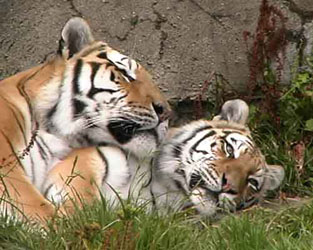

Tiger facts...
NAME
The scientific name for a tiger is Panthera tigris. Panthera is the genus, and the word means "Roaring Cats," which includes lions, tigers, leopards, and jaguars. The species "tigris" refers to the tiger and is the Latin word for tiger. The full "Linnaean" hierarchy for the tiger is:
EVOLUTION
Tigers and other carnivores descended from small mammals called miacids which lived during the early post-dinosaur Cenozoic Era about 60 million years ago. Miacids evolved over millions of years into several hundred different species, including cats, bears, dogs and weasels. About 37 cat species descended from the miacids. See The Making of the Cat for more.
Tigers evolved in eastern Asia, and while some of the earliest tiger fossils have been found in Siberia and China, the tigers exact original place is unknown. Tigers have only ever lived in Asia, although some scientists believe, based on fossil findings that they may have roamed into what is now Alaska during a time when the Bering strait was a land bridge. They have never lived in Africa. It is estimated that tigers have have roamed the earth for over 6 million years, although the earliest tiger fossils date back to somewhere between 1.5 and 2 million years ago and in approximately the same geographic distribution as modern tigers had a hundred years ago (when they still maintained a substantial range.)
Although scientists no longer classify tigers into subspecies, these names are commonly used to describe "races" of tigers from different regions that have slightly different physical characteristics. There were 8 subspecies of Tiger at the beginning of the 20th century. 3 are now extinct, leaving 5 existing subspecies.
LIFE EXPECTANCY, BIRTH, MATING
A typical tiger's life expectancy in the wild is 15-20 years; somewhat longer in captivity. The oldest tiger on record was 26 years.
Although there is no set mating season for tigers, breeding ofter occurs in the spring. The male may stay with the female for 20-80 days during this period, and then returns to its territory, never taking part in the rearing of the cubs. Gestation period is typically about 15 weeks.The female tiger, or tigris, can deliver several litters over her lifetime. Litter size ranges from 1 to 6, although rarely more than 2 or 3 survive. The cubs nurse for about 2 months, learn to hunt after about 11 months, and spend the first two years of their lives with their mother, before going out on their own. At this point, the mother will be ready to mate again, but if no cubs survived to maturity, the mother can mate again after 5 months. A mother is ultimately successful if two cubs survive to maturity.
SIZE AND FEATURES
The largest member of the cat family, they range in size depending on subspecies and gender. Typically 3 feet tall to the top of the shoulder, 7-10 feet long from the head to the rear end, with an additional 3 foot long tail, their weight ranges from 175-650 pounds. More on size can be found here.
The tiger is the only species of wild cat with stripes, which are actually pigmentation marks on the skin.
HABITS
Tigers prefer forested regions with available cool water and plenty of sources of food, which typically include deer, buffalo, wild pigs, porcupines and langur monkeys. They have also been known to eat fruit and grass to aid in digestion. Tigers are solitary and territorial, hunting alone and marking their territory by spraying the edge of it. Same sex territories don't overlap.
Tiger are at the top of the food chain and have no natural predators. Only man threatens their survival as a species. Tigers kill only for food and only when hungry. Rare cases of attacks on man usually turned out to be due to the tiger being put in a threatening, no escape situation. One section of the world, the Sundarbans mangrove on the borders of India and Bangladesh, have reported 800 human deaths attributable to tigers over the past 20 years. Since tigers almost always attack from behind, a double sided mask had been shown to be effective in preventing attacks.
ENDANGERED SPECIES
In early 1900's, world tiger population was estimated at around 100,000. By 1950, this number had dropped to 40,000. The reasons for their demise include poaching (fur, Chinese medicine, exotic recipes - 1 tiger per day is poached in India), deforestation (insecticides have reduced the danger of malarial mosquitoes in India, making land habitable that was previously home to tigers), and human expansion. The lowest point of tiger population was about 4000 in the 1970s. Due to conservation efforts, the total number of tigers in the wild has increased modestly since then to around 5000-7000 today. At least twice that number exist in captivity.
A dead tiger's parts are worth as much as $200,000 on the black market. The trade continues today in China, Taiwan, Korea, and Singapore, although tiger medicine is a hoax and has been shown to have no curative powers.
Tiger are protected under the CITES (Convention on International Trade in Endangered Species of Fauna and Flora) treaty. 158 countries have signed the treaty and agreed to abide by its terms, including those in which most tigers live. However, that has not stopped individual poaching. The tiger is officially classified as an Endangered Species, as are all of the remaining subspecies. They have been on the Endangered Species list since 1970.
